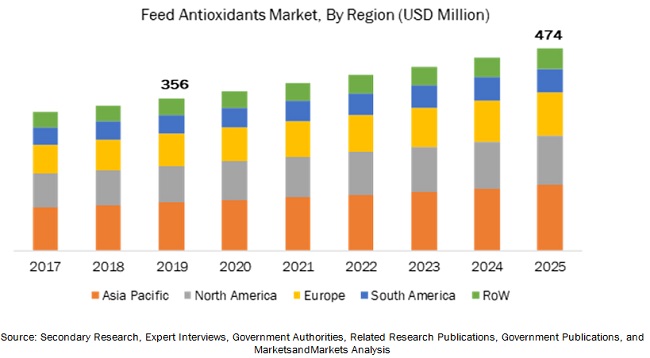The feed antioxidants market is estimated at USD 356 million in 2019 and is projected to reach USD 474 million by 2025. The global market is projected to grow at a rate of 4.9% during the forecast period. Factors such as the rise in demand for quality feed, improved technology for feed production, and an increase in the standardization of meat products stimulate the growth of the market across the globe.

Report Objectives:
- To define, segment, and project the global market size for the feed antioxidants market
- To understand the structure of the feed antioxidants market by identifying its various subsegments
- To provide detailed information about the key factors influencing the growth of the market (drivers, restraints, opportunities, and industry-specific challenges)
- To analyze the micromarkets, with respect to individual growth trends, future prospects, and their contribution to the total feed additives market
- To project the size of the market and its submarkets, in terms of value and volume, with respect to the regions (along with their respective key countries)
Download PDF Brochure:
https://www.marketsandmarkets.com/pdfdownloadNew.asp?id=138013648
The poultry segment is projected to account for the largest feed antioxidants market share, by animal
In poultry production, one of the major factors for feed is the cost; hence, reducing feed costs per bird is a priority. Poultry production has to be efficient as feed has to be converted into meat and eggs. Feed costs can be reduced by adding feed additives such as enzymes and antioxidants, which increase digestibility and prevent the loss of nutrients, with the result that the poultry gains more nutritional value from the same amount of feed. Companies such as Cargill, Koninklijke DSM N.V., and Kemin provide feed antioxidants such as carotenoids, tocopherols, synthetic antioxidants and citric acid, BHT, butylated hydroxyanisole (BHA), and tocopheryl acetate for the poultry industry.
The BHT segment is projected to account for the largest synthetic feed antioxidants market share
Synthetic antioxidants are generally produced as pure substances with consistent composition and are applied in well-defined mixtures with pure substances. Higher stability, easy availability, and low cost of production fuel the growth of the synthetic segment in the feed antioxidants market. Also, it protects fat-soluble vitamins and other nutrients against oxidative degradation, along with the loss of active ingredients in feed. Asia Pacific is projected to be the largest and fastest-growing BHT market. This is attributed to the growth of the feed industry in the region.
Make an Inquiry:
https://www.marketsandmarkets.com/Enquiry_Before_BuyingNew.asp?id=138013648
The Asia Pacific region is projected to account for the largest market share during the forecast period.
Asia Pacific accounted for the largest share of the feed antioxidants market in 2018. Asia Pacific, being the largest continent with a relatively fast economic development, is witnessing a rising demand for meat. Consequently, to produce quality meat, feed antioxidants are gaining importance and being incorporated to prevent spoilage and increase shelf-life.
This report includes a study of marketing and development strategies along with the product portfolios of leading companies in the feed antioxidants market. It includes the profiles of leading companies such as Cargill (US), Archer Daniels Midland Company (US), Koninklijke DSM N.V. (Netherlands), BASF SE (Germany), Nutreco (Netherlands), Kemin (US), Adisseo (France), Perstorp (Sweden), Alltech (US), Caldic (Canada), Novus International (US), Chemical Fine Sciences (India), Oxiris Chemical (Spain), VDH ChemTech (India), Zhejiang Medicine (China), BTSA (Spain), Bertol Company (Czech Republic), FoodSafe Technologies (US), Videka Company (US), Lallemand Animal Nutrition (Canada), and Industrial Tecnica Pecuaria (Spain).